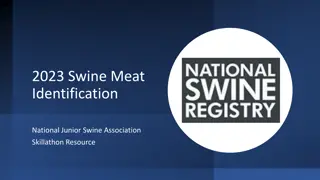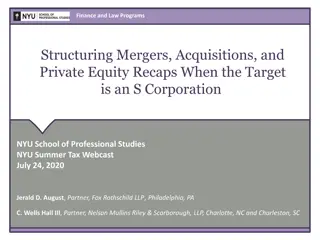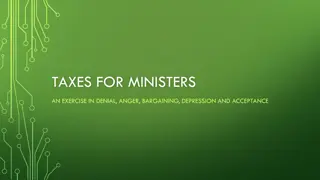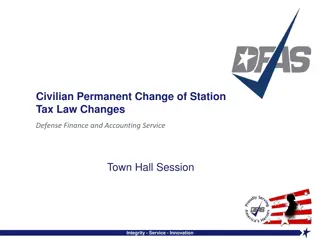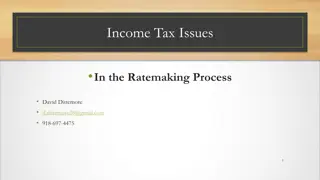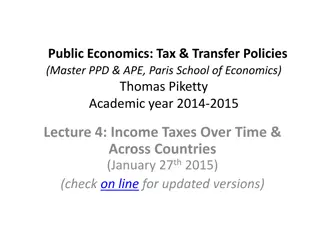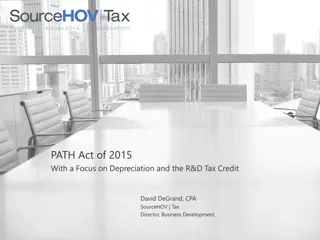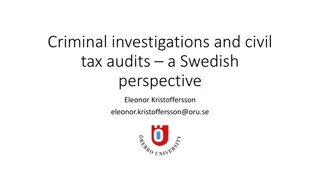Analysis of Winners and Losers in Tax Cuts and Jobs Act
Explore the impact of the Tax Cuts and Jobs Act on different individuals and groups as presented by Timothy J. Sundstrom, a CPA and CFP known as "Some Call Me Tim". Gain insights into who benefits and who may face challenges under this tax reform. Based in Broomall, PA, Tim provides valuable perspectives on the implications of this significant legislation.
Download Presentation

Please find below an Image/Link to download the presentation.
The content on the website is provided AS IS for your information and personal use only. It may not be sold, licensed, or shared on other websites without obtaining consent from the author.If you encounter any issues during the download, it is possible that the publisher has removed the file from their server.
You are allowed to download the files provided on this website for personal or commercial use, subject to the condition that they are used lawfully. All files are the property of their respective owners.
The content on the website is provided AS IS for your information and personal use only. It may not be sold, licensed, or shared on other websites without obtaining consent from the author.
E N D
Presentation Transcript
Tax Cuts and Jobs Act Who are the Winners and Losers? Presented by: Timothy J. Sundstrom, CPA, CFP
Tax Cuts and Jobs Act Who are the Winners and Losers? Timothy J. Sundstrom CPA, CFP Some Call Me Tim Tim is a CPA and financial planner located in Broomall, PA (suburban Philadelphia). He is the former president of the Pennsylvania Society of Public Accountants and for the last 13 years has been a lecturer with Thomson Reuters Gear Up Seminars and has authored several publications concerning tax and financial planning. Tim is a current member of the NSA tax committee. Tim currently lives in Havertown, PA with his wonderful wife Carina, and their brand new puppy Dixie. When Tim is not working he enjoys reading, gardening, traveling and of course walking the dog.
Learning Objectives: Upon completion of this course, you will be able to: Discuss the major changes to personal returns. Explain the flow through deduction. Discuss the major changes with regard to corporations.
Tax Cuts and Jobs Act Signed into law December 22, 2017 Most provisions begin in 2018 with some minor exceptions. Most changes are temporary! Most expire after 12/31/25. These changes I have labeled 2018 to 2025 . Large use of Suspension- Personal exemptions, miscellaneous itemized etc. Already push back on SALT reduction- Already proposals to restore deduction. No Postcard.
Tax Cuts and Jobs Act Warning: It is impossible to cover ever aspect of the Act in 4 hours or for 8 hours for that matter. We all need to take the time to really understand these rules.
Quick Review- of Individual Changes New income tax rates and brackets Standard deduction increased Personal exemptions suspended New Chained CPI changes Kiddie tax has been modified AMT was modified but retained Shared responsibility penalty set to zero
Quick Review- of Individual Changes State and local taxes caped at $10,000. Elimination of the home equity provision Modification of the Mortgage limit Changes in contributions including college athletic seating rights
Quick Review- of Individual Changes Medical thresholds reduced- 7.5% Alimony deduction suspensions for agreements after 12/31/18 Miscellaneous 2% itemized suspended PEASE limitation suspended Qualified Bicycle commuting suspended Moving expenses and reimbursements suspended- except members of armed forces
Quick Review- of Individual Changes Student loan discharge added for death or disability Deduction for living expenses for Congress eliminated Combat zone treatment extended to Sinai Peninsula Child tax Credit increased to $2,000 Non-Child Tax Credit Personal Casualty losses suspended- Disaster losses allowed
Quick Review- of Individual Changes New disaster relief provisions 2016 disasters for years 2016/2017. Repeal of the re-characterization of Roth conversions Length of service award programs for public safety volunteers increased to $6,000. Extended rollover for plan loans.
Quick Review of Business Changes New limit on excess business losses New holding period for carried interest- partnerships Self-created patents, inventions, designs, formulas, are no longer capital assets.
Quick Review of Business Changes Flat 21% corporate tax rate- no PSC rate! Corporate AMT repealed Reduction in the dividends received deduction percentage Code Sec. 179 increased to $1,000,000 with acquisition limit of $2,500,000. Expanded use of 179, bonus depreciation and 15 year life changes for qualified improvement property.
Quick Review of Business Changes 100% Bonus for property placed in service after 9/27/17- can be used for both new and used property. New Interest limits will not affect businesses under $25 million in gross receipts. Net Operating losses- 2 year carryback rule is repealed.
Quick Review of Business Changes Domestic production deduction repealed- New flow through deduction! Like-kind exchanges limited to real estate Five-year write off of specified R&E expenses Entertainment deductions no longer allowed In-house cafeteria on premise now only 50% deductible
Quick Review of Business Changes New Credit for paid family leave Changes in Employee achievement awards- no cash, gift cards, vacations, tickets. Limitations on executive compensation No deduction for lobbying, sexual harassment non disclosure
Quick Review of Business Changes Cash method up to $25 million in average gross receipts No inventory or UNICAP up to $25 million in average gross receipts Small Contractor exceptions to PCM - $25 million in average gross receipts New Pass-through deduction
Quick Review of Business Changes Repeal of the technical termination of partnership provisions New look-through rules for foreign partners on sale of partnership interests Changes in substantial built-in loss revised Electing Small Business Trust(ESBT) modified to allow for a nonresident alien as potential beneficiary New changes for S Corps revoking S Election in favor of C Corporation.
Quick Review of Other Provisions Estate and gift tax exemption increased to $10,000,000 indexed Luxury automobiles limits increased New farm equipment is 5 year property
Proposals that Did Not Make it (Not all inclusive) The elimination of estate tax after 2023 The complete elimination of AMT for individuals Increasing period for ownership and occupancy to exclude gain on sale of a residence Extending the American Opportunity Tax Credit (AOTC) to 5 years Increasing deduction for teachers to $500 Inclusion in income tuition reduction programs Repeal of exclusion of interest from US Bonds used for higher education Repealing deduction for student loan interest Termination of contributions to medical savings accounts Eliminating credit for plug-in electric vehicles Repealing completely Schedule A deduction for medical expenses Repeal of employer provided child care credit Repeal of Work Opportunity Credit
How Long Will It Last? Expiration of Provisions After 8 Years and the Byrd Rule Most Individual Provisions Expire After 2025 New Rates and Brackets Increased Standard Deduction Suspended Exemptions Non-child Dependent Credit 60% of AGI Charity SIT Limit to $10K Home Equity Suspended Casualty and Theft Losses Moving Expenses Reimbursements Increased AMT Exemption Savers Credit and ABLE Doubled Estate Tax Exemption Disaster Losses & Standard Deduction Child Credit Increase Mortgage Debt $750K Limit Business Loss Limitations Gambling Expense Limitations Qualified Bicycle Increased ABLE contributions Student Loan Discharges QBID
The Basic 1040 Gains Lower ordinary tax rates Larger standard deductions Child Tax Credit doubled Improved AMT Structure Back to 7.5% for medical expenses Loss Personal Exemptions suspended SALT Limited Casualty on for disaster 2% Miscellaneous itemized deductions suspended
Single Tax Brackets Prior Law 2018 New Law 2018 Taxable income Rate Taxable Income Rate 0-9,525 10% 0-$9,525 10% 9,525-38,700 15% $9,525-$38,700 12% 38,700- 93,700 25% $38,700-$82,500 22% 93,700- 195,450 28% $82,500-$157,500 24% 195,450- 424,950 33% $157,500-200,000 32% 424,950-480,050 35% $200,000-500,000 35% Over 480,050 39.6% Over 500,000 37%
Joint and Surviving Spouse Returns Prior Law 2018 New Law 2018 Taxable income Rate Taxable Income Rate 0-19,050 10% $0-$19,050 10% 19,050-77,400 15% $19,050-$77,400 12% 77,400-156,150 25% $77,400-$165,000 22% 156,150-237,950 28% $165,000-$315,000 24% 237,950-424,950 33% $315,000-$400,000 32% 424,950-480,050 35% $400,000-$600,000 35% Over 480,050 39.6% Over 600,000 37%
Up to 32% Bracket Tax Table Aligns Rate Single MFJ MFS 10% $0-$9,525 $0-$19,050 $0-$9,525 12% $9,525-$38,700 $19,050-$77,400 $9,525-$38,700 22% $38,700-$82,500 $77,400-$165,000 $38,700-$82,500 24% $82,500-$157,500 $165,000-$315,000 $82,500- $157,500 32% $157,500-$200,000 $315,000-$400,000 $157,500-$200,000 35% $200,000-$500,000 $400,000-$600,000 $200,000-$300,000 37% >$500,000 Over $600,000 Over $300,000 2018 All rates starting in 2018 are in line up to the 32% bracket.
Are We Going to File More MFS Returns? The Law did not change any of the following MFS negatives including but not limited to: One spouse itemizes the other must also. Taxpayer can only deduct expenses actually paid by them- Community state rules differ. Credits not available such as child care, adoption, education and earned income credit. IRC 121 is $250K each rather than a total $500K
Are We Going to File More MFS Returns? The Law did not change any of the following MFS negatives including but not limited to: Inability to offset one spouse passive income against the other s passive loss. SS provisional income for 85% is zero if the taxpayers lived together IRA deduction and Roth eligibility phase out at $10,000. The SALT Limitation is $5,000
Head of Household Rates still better Up to 12% Bracket Rate 10% 12% 22% 24% 32% 35% 37% Single $0-$9,525 $9,525-$38,700 $38,700-$82,500 $82,500-$157,500 $157,500-$200,000 $200,000-$500,000 >$500,000 Head of Household $0-$13,600 $13,600-$51,800 $51,800-$82,500 $82,500-$157,500 $157,500-$200,000 $200,000-$500,000 >$500,000
Head of Household Rate Prior Law Taxable income 0-13,600 13,600-51,850 51,850- 133,850 133,850- 216,700 216,700- 424,950 424,950-480,050 Over 480,050 2018 Rate 10% 15% 25% 28% 33% 35% 39.6% New Law Taxable Income 0-13,600 13,600-51,800 51,800-82,500 82,500-157,500 157,500-200,000 200,000-500,000 Over 500,000 2018 Rate 10% 12% 22% 24% 32% 35% 37%
Head of Household New Law: For years beginning after 12/31/17- due diligence requirements are imposed on returns taking the Head of Household Status. (Code Sec 6695(g))
Standard Deduction New Law (2018) Prior Law (2018) Single (and MFS) Head of Household Joint / Surviving Spouse Dependent Addition for Elderly or Blind Single Married Each Personal Exemption $ 6,500 $ 9,550 $ 13,000 $ 1,050 $ 12,000 $ 18,000 $ 24,000 1,050 $ 1,600 $ 1,300 $ 4,150 $ 1,600 $ 1,300 Suspended
Alternative Minimum Tax (2018-2025) AMT is retained by the exemption amounts are increased. Old Law New Law Exemption Phase Out Exemption Phase Out MFJ/ SS $86,200 $164,100 $109,400 $1,000,000 Unmarried $55,400 $123,100 $70,300 $500,000 MFS 50% MFJ 50% MFJ 50% MFJ 50% MFJ 42
Hardworking Young Couple with 3 Kids 2017 289,609 $ (4,125) 285,593 (1,021) 284,572 (58,385) (20,250) 205,937 44,547 5,979 50,980 2018 289,609 $ (4,125) 285,593 (1,021) 284,572 (39,700) 244,872 47,348 47,348 6,000 Change Wages Interest Business Income Total Income H.S.A. AGI Itemized Exemptions Taxable Income Federal Tax AMT Additional Taxes Total Tax Credits 109 109 18,685 20,250 38,935 2,801 (5,979) (3,632) 6,000 - - 454 454 - - Total Tax Bill 50,980 $ 41,348 $ (9,632) $
Capital Gain Rates Married Filing Joint/Qualified Widow Taxable Income Married filing Separately Single HOH Rate 2017 2018 2017 2018 2017 2018 2017 2018 $0 75,900 $75,901 - 470,700 Over $470,70 0 O% $0-77,200 $0-37,950 $0-38,600 $0-37,950 $0-38,600 $0-50,800 $0-51,700 $77,201- $479,000 $37,951 $235,350 - $38,601- $239,500 $37,951- 418,400 $38,601- 425,800 $50,801- 444,550 $51,701- 452,400 15% Over $479,000 Over $235,350. Over $239,500. Over 418,400. $ Over $425,800. Over $444,550 Over $452,400 20.00% NIIT- MAGI > $250,000 > $125,000 > $200,000 >$200,000
Capital Gain Rate Structure Maximum Capital Gain/ Qualified Dividend Amounts 0% 15% $479,000 $452,400 $425,800 Joint/Surviving Spouse Head of Household Any Other Individual $77,200 $51,700 $38,600 Estate & Trust $2,600 $12,700 Refers to Maximum 0% and 15% amounts. The 3.8% Net Investment Income Tax (IRC 1411) was retained.
Child Tax Credit/ Family Credit- (2018 -2025) Old Law: Child Tax Credit was $1,000 for each qualifying child under age 17 the amount was subject to a phase out. New Law: Provides an Enhanced Child Credit Credit increased to $2,000 with $1,400 refundable. Non refundable credit of $500 for non-child dependent Child must have a SSN.
Enhanced Child Tax Credit and New Family Credit Phase-out All above credits subject to phase-out Phase-out remains at $50 for each $1,000 or part thereof as AGI exceeds following thresholds: Child Tax Credit Analysis Phase Outs Filing Status MFJ Single, QW, HOH MFS 2017 2018 $400,000 $200,000 $200,000 $110,000 $75,000 $55,000 Phase outs are not adjusted for inflation.
Maidless Couple - 5 Children both CTC Qualifying and Non-qualifying Maidless Married Filing Joint Return 5 Children Eligible for CTC Children Not Eligible for CTC 2016 $105,000 $105,000 105,000 12,600 28,350 64,050 2018 Change 2016 2018 Change Wages Total AGI Standard Deduction Exemptions Taxable Income $0 $105,000 $105,000 0 105,000 $11,400 12,600 -$28,350 28,350 16,950 64,050 $0 0 105,000 24,000 105,000 24,000 $11,400 0 0 -$28,350 81,000 81,000 16,950 Federal Tax Child Tax Credit Net liability(Refund) Net Savings 8,684 5,000 $3,684 9,699 10,000 -$301 $1,015 $5,000 -$3,985 8,684 9,699 2,500 $7,199 $1,015 $2,500 -$1,485 0 $8,684 $8,907 plus 22% over 77,400
Mademores with 5 Children Eligible and Not Eligible MadeMores Married Filing Joint Return 5 Children Eligible for CTC Children Not Eligible for CTC 2016 $200,000 $200,000 200,000 12,600 28,350 159,050 2018 Change 2016 2018 Change Wages Total AGI Standard Deduction Exemptions Taxable Income $0 $200,000 $200,000 0 200,000 $11,400 12,600 -$28,350 28,350 16,950 159,050 $0 0 200,000 24,000 200,000 24,000 $11,400 0 0 -$28,350 16,950 176,000 176,000 Federal Tax AMT Child Tax Credit Net liability(Refund) 31,520 1,312 38,010 $6,490 -$1,312 $10,000 -$4,823 31,520 1,312 38,010 $6,490 -$1,312 $2,500 $2,678 0 10,000 $28,010 0 2,500 $35,510 $32,832 $32,832 $32,089.50 plus 32% over $157,500
Kiddie Tax Old Law: The net unearned income of a child was taxes at the parent rates once the unearned income exceeded $2,100. The provision applied to any child under age 19 and full-time college students under age 24.
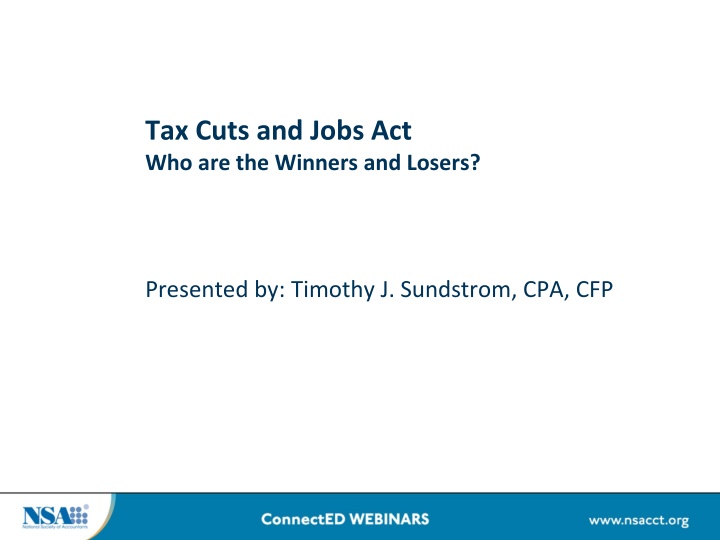

![Town of [Town Name] Real Estate Tax Rates and FY 2024 Budget Summary](/thumb/62211/town-of-town-name-real-estate-tax-rates-and-fy-2024-budget-summary.jpg)
